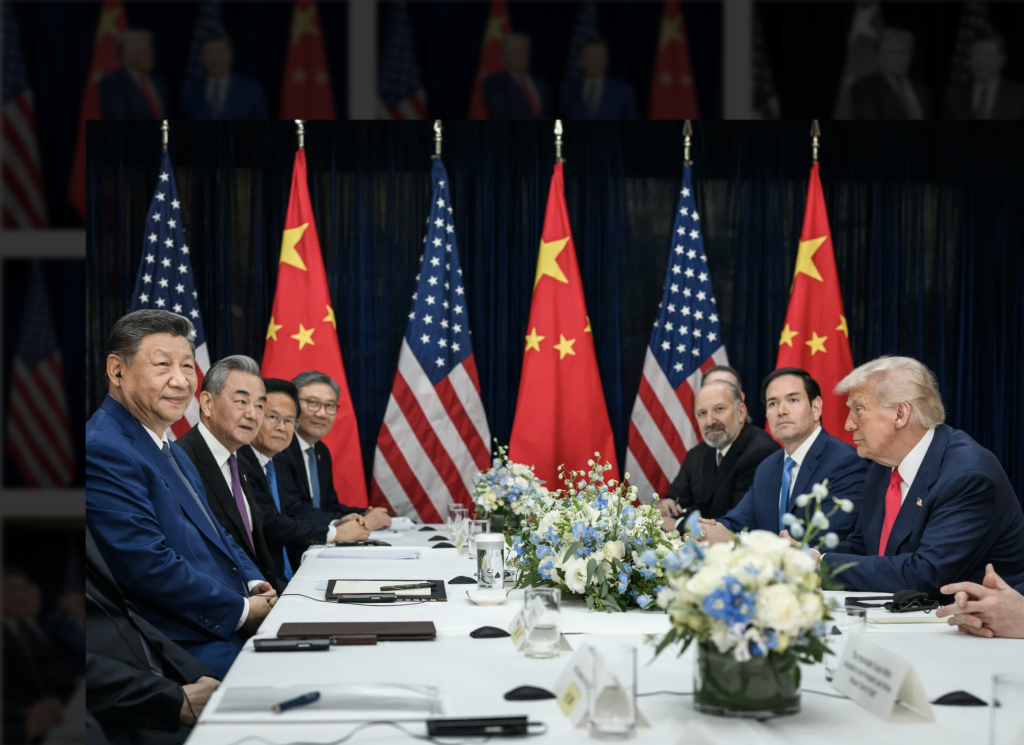Positioning America’s Strength: Speak Realities, not Opinions
The much-anticipated visit of Wendy Sherman brought some cautiously optimistic prospects to U.S.-China relations in the Biden era. After years of blunt criticism and saber-rattling in maritime security, trade relations, and cybersecurity, America’s second-highest ranking diplomat met with Foreign Minister Wang Yi in Tianjin to set “guardrails” for the two great powers’ future engagement. Deputy Secretary Sherman stressed that the U.S. welcomes competition with China but is committed to avoiding conflict. Tensions, however, remain strong after the meeting. It does not appear that Serman’s visit has or will change Beijing’s stance toward the United States, international norms, and cybersecurity.
Given China’s assertive tenacity on these matters, it is understandable that the U.S. expected Sherman to adopt a resolute position at the talk, hence U.S. State Department Spokesperson Ned Price’s mention of a “position of strength” at the July 21 press briefing. China responded by calling out the U.S. for always thinking it is superior to other states. Five months ago, it was this attitude that triggered a tirade by Yang Jiechi, the Director of the Central Foreign Affairs Commission Office at the Anchorage meeting, where he argued that the U.S. does not deserve to speak from a ‘position of strength.’
As catchy as the phrase ‘position of strength’ may sound, the real issue at hand goes well beyond the rhetorical art of diplomatic signalling. Rather than fixating on whether the U.S. or China deserves a position of strength, foreign policy practitioners and scholars would be better served to consider how to position the two great powers’ strengths. As the U.S. and China enter an era of global challenges, diplomatic dynamics will be a function of what each country can actually do as opposed to what claim about themselves. For the U.S., an alarmist overestimation of Chinese strength is dangerous because, as Ryan Hass argued, “Such panic [about China’s strength]…risks causing the United States to focus too little on the more essential task of bolstering its own.” For China, turning a blind eye to its domestic vulnerabilities while taking American decline as an irreversible trend is similarly unwise, as such misperception will encourage Chinese decision-makers to act imprudently and assertively in the international system. Considering contemporary China’s fever pitch nationalism, analyses that cherry-pick America’s relative decline to China may be very well-received domestically, but nevertheless risk propagating a risky underestimation of American strength.
In this sense, a sober discussion of respective advantages is beneficial for both the US and China to position their strengths in future engagements. The “strength” is relative to the issue area in which a specific political or economic muscle is required to lift the weight of competition. A pragmatic review of what remains of American strength builds a case of confidence and helps navigate the waters of U.S.-China relations as interdependence deepens.
In the context of the trade war, for example, China proudly highlights that it is America’s largest trading partner and biggest import source, and that Americans therefore have shot themselves in the foot by continuining to antagonize China over trade. While it is true that the trade war so far has once cost the US 245,000 jobs and that most American businesses remain heavily invested in the Chinese market, to call this interdependence a source of strength for China in a competitive sense is misleading. For instance, despite China being the largest market for semiconductors, it is not responsible for most of the value it produces. In fact, how much a country is responsible for a product’s value-added is a much better indicator of not only how much profit a country can earn from a product, but also the country’s relative importance in the production cycle. The U.S. remains home to the most value created in the semiconductor global supply chain, producing 38% of the entire value chain compared to China’s 9%. Furthermore, in 2019, the U.S. produced 74% of the electronic design automation (EDA) and core intellectual property (IP) and 41% of the advanced manufacturing equipment whereas China supplies less than 5% of the EDA and core IP and 5% of the manufacturing equipment. This comparison becomes more stark when accounting for key American allies such as Japan and South Korea, who alone contributed 14% and 16% of the semiconductor value chain respectively.
This explains why Huawei and ZTE suffered so greatly when the Trump administration imposed several bans and sactions on products from Chinese-linked tech companies. Under these policies, U.S. semiconductor companies were banned from selling to ZTE, severing the company’s supply of chips and compelling the company to capitulate in July 2018. American entities, broadly defined, were also restricted from doing business with Huawei, rendering the Chinese tech company’s app ecosystem in limbo as Huawei phones could no longer use Google apps. Coupled with the ban on semiconductors, Huawei’s product shipment plummeted 41% in the last quarter of 2020 with a market share of 8%. The Biden administration has continued to position American strengths to take advantage of the fact that American technology is indispensable to the global high-tech industry. Given America’s unrivaled leadership in semiconductor innovation, China stands to lose greatly in a prolonged trade standoff. Indeed, Americans would certainly see higher prices for its high-tech products, but not being able to assemble and export products powered by core U.S. technology would cost China hundreds of thousands of jobs and hamper its export-driven economy.
If China wishes to remove the US from the equation and realize self-sufficient “internal circulation内循环”, as the Chinese leadership proposed in 2020, the cost to achieve a regional supply chain alone in semiconductors would cost at least $1 trillion up front. The high-tech challenge is further complicated by the Chinese regime’s bold actions to exclude foreign tech companies and tighten control over its own internet tech giants. Domestic internet leaders like Didi and Alibaba fell victim to the regime’s sweeping antitrust and legal review actions. Foreign tech companies are discouraged from entering the market by the regime’s stringent internet regulations. Meanwhile, American universities continue to siphon talent from China even amid the pandemic and several Trump-era visa restrictions. In 2020, Chinese parents are no less eager to send their children to study in the U.S. On October 14th, 2020, ETS opened registration for the January to August administrations of the 2021 TOEFL in Beijing and Shanghai. According to some Chinese sources, the slots were filled entirely in 5 minutes.
The positioning of American strength is even more convincing when we consider demographic and strategic realities in China which are unlikely to change despites its more assertive behavior in the international community. First, China’s economic growth is unlikely to be sustainable given an aging population and a unrecoverably low birth rate. For the past two decades, fueled by the momentum of a population dividend, China’s miraculous economic growth made the most populous country a peer contender with the U.S. This trend, however, is no longer in linear growth as the country grows old a lot faster than it gets rich. China’s most recent population census already reveals that a population crisis is imminent, with only 12 million births in 2021, the lowest since 1961. At the same time, as a generation of workers retires, the retirees will over-tax the pension system beyond its limits by 2028, leaving a deficit of as much as 11 trillion yuan by 2050. The regime’s long-term solution—relaxing the birth policy to three children per family— looks pale before the enormity of the problem. Experts doubt whether that would bring up the fertility rate of 1.3 children per woman. The “outrageous cost” of raising a child in China’s big cities such as Beijing and Shanghai has reached a staggering amount, 840,000 RMB in some cases, enough to discourage young couples from having children entirely.
Second, China must contend with geopolitical and military-strategic realities that are immutable to its economic might. The Quadrilateral Security Dialogue (Quad) brings India to the American-led Indo-pacific network, allowing this nuclear-armed nation to seek a new level of military interoperability with the U.S. in the region. Forward-deployed U.S. forces also check the Chinese Navy’s ability to operate anywhere in the open sea and project its naval power beyond the area off its coastline. More importantly, the fact that China will not possess a blue water navy that rivals that of the U.S. and its allies in the next few decades means that China will not be able to keep its food and energy insecurity under control should a conflict break out. As China imports half of its oil from the Middle East and has a 90 million hectares shortage of planting area, food and energy insecurity will loom over the country regardless of its economic status in a naval blockade scenario.
In sum, it is likely immaterial whether the US is qualified to speak from a position of strength if it already has the upper hand in the game. There is little reason to suspect that America’s core strength regarding the economic value chain, technological innovation, and alliance-enabled military superiority is diminished in a zero-sum manner as China gains momentum in one or many of these areas. The question is how the U.S. and China should position their strengths to co-exist with growing nationalism and prosper in a world of competitive interdependence and global challenges such as the COVID-19 pandemic and climate change. After all, managing U.S.-China relations requires a sober view of the two country’s concrete capabilities and assets. Whether diplomats should or should not feel that the other side deserves to enter the room with their heads held high is simply not the issue at hand.








